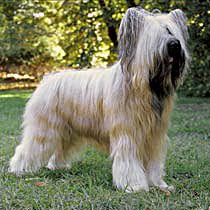|
The Canine Chronicles Directory
Briard

Briards are handsome, rugged and well-proportioned dogs. They have a long, coarse
double coat. The coat of the Briard is lighter when they are puppies and deepens
as they get older. Preferred colors for the show ring are all shades of fawn, solid
black or black with white hairs scattered throughout. All white is not desirable.
The slightly rounded skull has a clearly defined stop and a square, strong muzzle.
The large eyes should be dark brown and the nose black. The ears should set high
on the head. They are generally cropped but can also be left natural. The teeth
should be strong and meet in a scissor-like bite. The muscular neck should be moderately
long adjoining strong sloped back shoulders. The level back should be firm and the
forelegs strong boned. The thighs of the hindlegs should be well-muscled with double
dewclaws low on the leg. The feet have firm, hard pads and with closed toes. The
long tail is carried low and has an upward hook.
|
|
Temperament
|
Briards' are brave, loyal, and sweet natured. They make good family dogs. They tend
to bond with one person out of the family more than the others. They need to feel
a part of the family and will regard strangers suspiciously. They are protective
by nature and have keen memories. They have been known to protect the children from
parental correction. They enjoy playing games however they can become rough, but
not vicious, very quickly. Younger children should be monitored around this breed.
If not socialized, Briards can become aggressive towards other dogs. This breed
is accepting of household pets if introduced to them.
|
|
Height, Weight
|
Male Height: 24-27" ; Weight: About 75 lbs.
Female Height: 22-25" ; Weight: About 75 lbs.
|
|
Health Problems
|
Though normally a healthy breed, Briards can be prone to hip dysplasia, PRA, bloat
and cataracts.
|
|
Living Conditions
|
Briards will do fine with apartment living if given regular exercise. They love
to run and be outdoors. This breed is not suited for kennel living. They need to
be a part of and with their families.
|
|
Exercise
|
This breed likes running and swimming. They make excellent jogging companions as
well as running alongside a bicycle. They will become restless if not exercised
properly.
|
|
Life Expectancy
|
About 10-12 years
|
|
Grooming
|
If well groomed, the Briard is a beautiful animal. Thorough and daily brushing and
grooming is necessary to prevent matting. This breed sheds very little. Trim inside
the ears and between the toes regularly.
|
|
Origin
|
The exact origin of the Briard is unknown. However, legend has it that they were
established in Europe during the Middle Ages. It has been said that they stemmed
from Oriental sheep-herding dogs and crossed with local guarding breeds. An ancient
tale states that Aubry of Montdidier was murdered with only his dog as a witness.
The King was eventually made aware that the dog was continually following the killer.
He ordered a dual between the killer and the dog (common during the Middle Ages).
The dog won! The Briard has been said to have the same physical and working abilities
as in Aubry's tale, suggesting the dog was a Briard. Charlemagne gave Briards as
gifts to friends and Napolean took the breed with him on military campaigns. Thomas
Jefferson imported this breed to assist farmers in the United States and Lafayette
imported them to be used on his American estate. The breed built a reputation for
being trustworthy in battle and was named the official dog of the French army. They
would carry supplies to the front lines, served as sentries and located the wounded.
They had an uncanny sense of which soldiers would live and die. Due to their sturdy
bodies, they were also used to carry machine gun ammunition belts to the gunning
replacements. American soldiers were so impressed that the breed was quickly imported
to the United States. The Briard is recognized by the AKC and the UKC.
|
|
Group
|
AKC and UKC Herding Dog
|